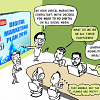User experience design: Hot new tech skill for 2017

The day Steve Jobs introduced the first iPhone to the world, a revolution took place that eventually led to the way we live today. What distinguishes an iPhone/MacBook from its competitors with similar or even better functionality is its superior user experience or UX.
UX refers to the overall experience of a person using a product, be it a website or a computer application, especially in terms of how easy or pleasing it is to use. And experience designers are the people who make it convenient and pleasant for customers to use these continuously evolving technological products.
A famous Silicon Valley saying goes like this: "A user interface is like a joke. If you have to explain it to people, then it's not that good." Technology is embedded in our lives. For many people, they're literally connected from the time they wake up till the time they go to bed. Unfortunately, using technology can be difficult and frustrating, especially if it's a new technology. An experience designer's ultimate goal is to make using technology not only possible, but also fun and enjoyable. So what do experience designers do in their day-to-day lives? They try to understand how humans interact with technology so they can empathise with a user's pain points and figure out how they can make the experience more useful, usable and compelling. To generate a better understanding, they might keep their field work as simple as interviews, personas and user journeys or as advanced as full-blown prototypes and behavioural observations.
UX design has become a major job field in the service sector. Globally, a good number of industries including, but not limited to, telecommunication, banking, healthcare, hospitality, creative agencies, and software developers are hiring UX designers to make their products and services ready for the digital world. A recent study on global brands showed that organisations that use and embed design in their core tend to have 200% more profitability than their competitors. Tesla, Apple, Uber, Spotify are some of the best examples of companies leveraging great UX for higher profitability.
Here's the top 10 in-demand tech skills in 2017 according to LinkedIn
With Bangladesh moving rapidly towards a digitalisation movement, this profession is becoming relevant here also. Telecom and banking sectors are already embracing the potential of UX design. Md. Moinuddin Bhuiyan, Head of Design & UX team at Grameenphone said: "Understanding customers better enables us to be more relevant and meaningful and helps deliver more value to them. Our team is sharing resources, competencies, and best practices with the global community of designers across all Telenor business units and trying to contribute to the local community representing and promoting a design-driven organisational culture." Besides local opportunities, Bangladesh can also become a global hub of experience design outsourcing given the sheer number of talented app and software developers around.
So how does one prepare himself/herself to become an experience designer? "It's best to start early while you're still in uni and gain experience as a part-timer or intern at different digital and tech companies", commented Bushra Zerin, who is working as a Creative Conveyor at CoDesign Ltd. Although currently there is no formal tertiary level degree available in Bangladesh on UX design, there are plenty of opportunities waiting abroad for interested students. Besides, the option of self-learning through various online educational sources, like Coursera, is always available. The main point to remember here is that becoming a UX designer is all about understanding human interaction, which is a continuous learning process throughout one's life.
UX design is going to be one of the top 20 professions at the global level in the next few decades. Now is the right time for Bangladeshi students to grab this opportunity and prepare themselves for this field of immense opportunity. Amit Seal Ami, Lecturer at the Institution of Information Technology, University of Dhaka, explained the bottom-line in a simple way: "There will always be similar service providers, so the one who provides better UX for its customers will stay ahead of the competition".
The author is marketing professional currently working as pricing strategist in a leading telecom operator. He can be reached at [email protected]
Illustration: Ehsanur Raza Ronny

 For all latest news, follow The Daily Star's Google News channel.
For all latest news, follow The Daily Star's Google News channel. 







Comments